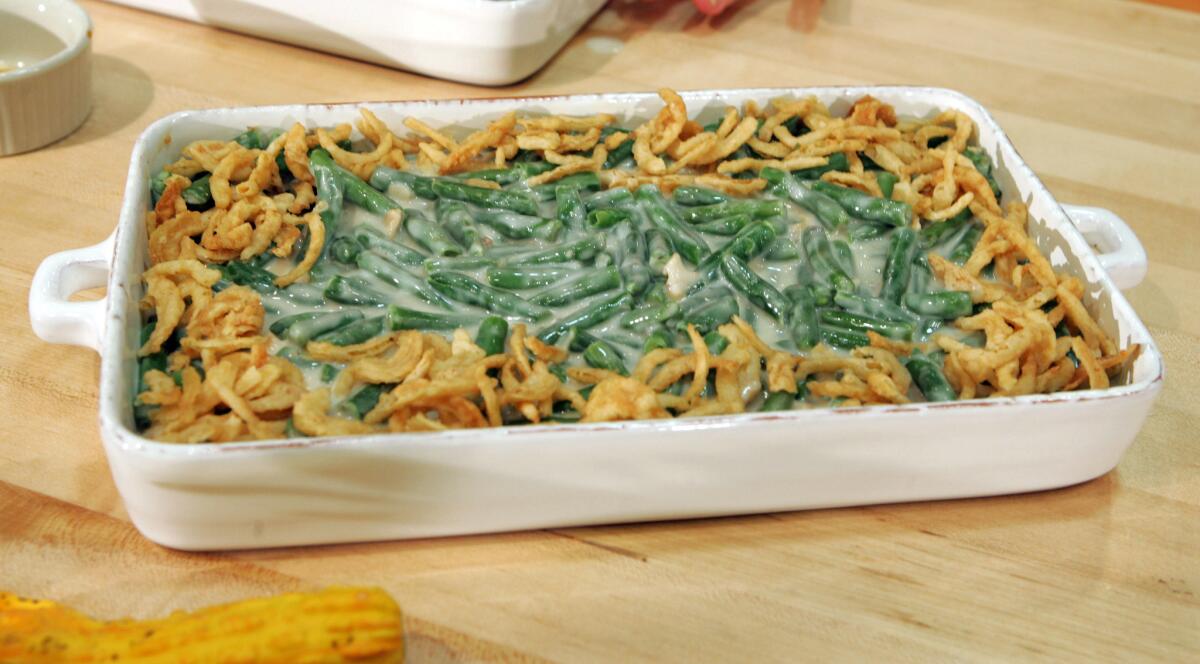Op-Ed: Green-bean casserole, the corporate side dish with nostalgia baked right in

- Share via
Nobody showed up at the first Thanksgiving carrying a green-bean casserole. Whatever was on the menu at that semi-mythical gathering it didn’t include a dish made with string beans, canned cream-of-mushroom soup, a bit of soy sauce and canned french-fried onions. And yet, along with the turkey and cranberries we’ve enshrined as the culinary symbols of Plymouth colony, millions of home cooks will make green-bean casserole this year, a dish bearing every hallmark of its 20th century origins. Introduced in 1955 as “Green Bean Bake,” by the end of that decade it had become a holiday icon, right up there with pilgrim hats.
It’s a remarkable trajectory for a casserole born in a corporate test kitchen. Typically we’re reluctant to alter our holiday menus, packed as they are with memory and tradition. But no sooner had families across the country tasted green-bean casserole than they started saving space for it on the sideboard as faithfully as if they’d gotten the recipe from Great-Grandma.
Dorcas Reilly, the Campbell Soup Co. home economist who invented green-bean casserole, died last month at the age of 92. But happily for historians, her working notes on the project survive, typed up with some handwritten additions on a card headed “Vegetable — Oven” that the company donated to the National Inventors Hall of Fame. She started her experiments at the request of Cecily Brownstone, the food editor at the Associated Press. Brownstone had attended a press luncheon where “a simple casserole of green beans with an intriguing topping” caught everyone’s attention. She especially liked the backstory: On a trip to the U.S., the shah of Iran and his wife, Queen Soraya, had been served the same casserole, and the queen said she loved it. Brownstone asked Campbell’s to help her devise an easy recipe for the dish, suitable for home cooks using packaged foods, and Reilly took up the challenge.
Thanksgiving isn’t about elegance, it’s about America.
She tested version after version — was it better with celery salt? Or maybe Worcestershire sauce? Was a quarter-teaspoon of soy sauce enough? “Needs more pep so I stirred in extra soy sauce,” Reilly wrote. Several of her co-workers tasted the results, and it was one of these tasters, identified in Reilly’s notes only as “EH,” who came up with the inspired notion of including french-fried onions in the soup mixture as well as sprinkling them on top.
Brownstone published her story on April 21, 1955 (“Beans Fit for a Queen of Iran”), and although Reilly continued to tinker with the recipe for years, the dish was launched.
But notice the date of Brownstone’s story. This was a springtime recipe; Thanksgiving was nowhere in sight. Yet four years later, in November 1959, Ruth Ellen Church, the food editor at the Chicago Tribune, was reporting on what had already become “the popular treatment” for Thanksgiving string beans: Just bake them in mushroom soup with canned onion rings on top. Reilly’s invention, a plain-spoken homage to convenience and crunch, had leapt to classic status.
Enter the Fray: First takes on the news of the minute from L.A. Times Opinion »
Why green-bean casserole, of all possible candidates for immortality? The Campbell’s test kitchen was constantly turning out canned-soup recipes, many of them quite a bit more arresting than this one. Asparagus soup turned up in a cheese souffle, tomato soup was the operative ingredient in a molded gelatin salad, cream-of-mushroom soup was mixed with ground meat to become the filling for a French-toast sandwich — but none of these outlived their novelty.
Similarly, there are innumerable ways to serve green beans, but few can compete with the casserole on Thanksgiving. Tossing green beans with butter and slivered almonds, for instance, which Ruth Ellen Church suggested as an alternative, is easier; it’s also more elegant and doesn’t take up room in the oven. Never mind. Thanksgiving isn’t about elegance, it’s about America. Green-bean casserole appeals to a deeply characteristic streak in our national appetite, a sensibility that brings us back to packaged foods even when we think we’ve cut the ties.
Farmers markets, seasonal produce, “fresh and local” — these mantras are relatively recent preoccupations. Packaged foods, by contrast, are woven into our culinary DNA. What delighted the immigrants arriving at Ellis Island wasn’t fresh vegetables, but canned peaches, and fluffy white bread as sweet as cake. Those were the miracle foods that told newcomers they had arrived in the land of plenty, and the foods that shaped our tastes for generations. When Reilly and her team approved a just-right version of green-bean casserole, it was because they recognized a beloved old friend — the nostalgia was baked in.
“All liked,” Reilly wrote on the card. We still do.
Culinary historian Laura Shapiro is the author of “Something from the Oven: Reinventing Dinner in 1950s America” among other books.
Follow the Opinion section on Twitter @latimesopinion and Facebook
More to Read
A cure for the common opinion
Get thought-provoking perspectives with our weekly newsletter.
You may occasionally receive promotional content from the Los Angeles Times.









